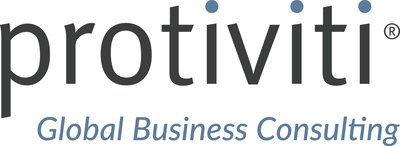Board and C-Suite Leaders Diverge on How to Address Critical Business Challenges, Study from Protiviti, Broadridge and BoardProspects Finds
- None.
- None.
Focusing on organizational resilience and accountability for performance are governance best practices that can enable directors and management teams to work more effectively
The study, which captures the views of more than 1,000 board members and C-suite executives from organizations worldwide across a variety of industries, found that while boards and C-suite leaders are aligned in goal and purpose, they do not always see eye to eye on how to get there. It is vital that directors and management teams strategically work to bridge these gaps as their companies continue to face an uncertain macroeconomic environment, an ongoing global war for talent, rising geopolitical risks, cyberattacks, the rise of generative AI and other existential business threats.
"While the board and C-suite each have their own part to play in the effective management of an organization, they must be on the same page when it comes to navigating the most complex and daunting challenges their companies will face," said Joe Tarantino, president and CEO of Protiviti. "In addition to these challenges, the survey also points a way forward for boards and the C-suite to work more effectively by implementing corporate governance best practices, fostering organizational resilience, collectively addressing growth obstacles, and holding each other accountable for continued strong performance."
Where the Board and C-Suite Diverge
Boards and the C-suite have many areas of agreement. Strategic planning and execution rates as the top board priority according to both groups. In addition, most director and C-suite respondents "agree" or "strongly agree" that board members provide valuable input into corporate strategy and major policy decisions.
However, when it comes to how well the board is carrying out its responsibilities, some differences emerge between the corner office and the boardroom. Ninety-two percent of board respondents rate themselves highly on placing the interests of the company ahead of their own interests, but only
"Board members and C-suite executives are working toward the same goals, but in some cases, the data shows they are taking different routes," said Mark Rogers, Founder and CEO of BoardProspects. "It's critical that leadership teams and their partners work together, otherwise it will be difficult to coordinate and execute nimble and competitive responses to changing trends, policies and other market threats."
On board and C-suite working dynamics and participation,
When it comes to addressing specific business risks or other business needs, there is misalignment between the board and C-suite on which priorities are not receiving adequate time and attention from the board, including:
1. Corporate culture
a.
b.
2. Environmental, social and governance (ESG)
a.
b.
3. Hiring and talent management
a.
b.
Addressing Business Threats
While board members and C-suite executives largely agree on the top headwinds facing organizations, there is also a significant perceived confidence gap on the board's ability to address them. Of the 15 organizational threats evaluated, in only three instances did more than half of respondents believe their board was "extremely" or "very" prepared to address them. These include:
1.
2.
3.
Overall, respondents believe their boards are ill-equipped to manage the remaining 12 risks, with the four lowest confidence scores being:
1.
2.
3.
4.
How Boards Can Take Action
"Enhancing the dialogue between the C-suite and board members is critical as companies strive to keep pace with technology and the evolving marketplace and this study highlights both the strengths (strategic planning, execution rates and risk management) and areas of greater opportunity (digital transformation, new technologies and cybersecurity)," said Michael Tae, Co-President of Broadridge's Investor Communication Solutions. "Good corporate governance requires an engaged and active approach, in order to improve both board and C-suite performance and foster growth prospects."
The results of the survey reveal several key strategies to improve board governance and performance. Actions that boards and their management teams can take include:
1. Sharpening focus on crisis management, cybersecurity issues, and organizational resilience.
2. Identifying methods of mutual accountability to improve director engagement, assess board performance, and manage underperforming directors.
3. Working together to address obstacles to organizational growth.
Resources Available
"Views on Board Governance - Where Directors and C-Suite Leaders Align and Diverge" from Protiviti, Broadridge and BoardProspects is available for complimentary download here. The report is broken out by company type, size, industry, geographic region and respondent role. Protiviti's global webinar series kicks off on March 19, 2024, with a one-hour panel discussion on the survey's findings. It will be hosted by Protiviti and feature executives from Broadridge and BoardProspects. Attendance is free with registration here. If you cannot attend live, the recording can be accessed anytime here.
Methodology
Protiviti, Broadridge and BoardProspects conducted the Global Board Governance Survey in the fourth quarter of 2023. The companies polled more than 1,000 (n=1,006) board members and C-suite executives. For a number of questions, the responses of directors who serve on multiple boards reflect the largest company for which the director serves on the board.
About Protiviti
Protiviti (www.protiviti.com) is a global consulting firm that delivers deep expertise, objective insights, a tailored approach and unparalleled collaboration to help leaders confidently face the future. Protiviti and our independent and locally owned Member Firms provide clients with consulting and managed solutions in finance, technology, operations, data, analytics, digital, legal, HR, governance, risk and internal audit through our network of more than 85 offices in over 25 countries.
Named to the 2023 Fortune 100 Best Companies to Work For® list, Protiviti has served more than 80 percent of Fortune 100 and nearly 80 percent of Fortune 500 companies. The firm also works with smaller, growing companies, including those looking to go public, as well as with government agencies. Protiviti is a wholly owned subsidiary of Robert Half Inc. (NYSE: RHI). Founded in 1948, Robert Half is a member of the S&P 500 index.
About Broadridge
Broadridge Financial Solutions (NYSE: BR), a global Fintech leader with over
For more information about us, please visit www.broadridge.com.
About BoardProspects
BoardProspects is the premier board recruitment solution for public and private companies. Founded in 2010, the innovative technology platform offers for-profit corporations of all sizes a cost-effective way to identify, assess, and recruit board members from a prestigious community of highly-regarded and credentialed board members, c-suite executives, and thought leaders. In 2023, more than 395 corporate board seats were filled through the BoardProspects platform.
Protiviti is not licensed or registered as a public accounting firm and does not issue opinions on financial statements or offer attestation services.
![]() View original content to download multimedia:https://www.prnewswire.com/news-releases/board-and-c-suite-leaders-diverge-on-how-to-address-critical-business-challenges-study-from-protiviti-broadridge-and-boardprospects-finds-302092948.html
View original content to download multimedia:https://www.prnewswire.com/news-releases/board-and-c-suite-leaders-diverge-on-how-to-address-critical-business-challenges-study-from-protiviti-broadridge-and-boardprospects-finds-302092948.html
SOURCE Protiviti
FAQ
What is the significance of the Global Board Governance Survey conducted by Protiviti, BoardProspects, and Broadridge Financial Solutions, Inc. (NYSE: BR)?
What are the key areas of agreement between boards and the C-suite according to the survey?
What are the differences between board members and C-suite executives in terms of self-assessment on responsibilities?
What are the areas of misalignment between the board and the C-suite in addressing business risks?
Which organizational threats do board members and C-suite executives agree on, but with a confidence gap on the board's ability to address them?








